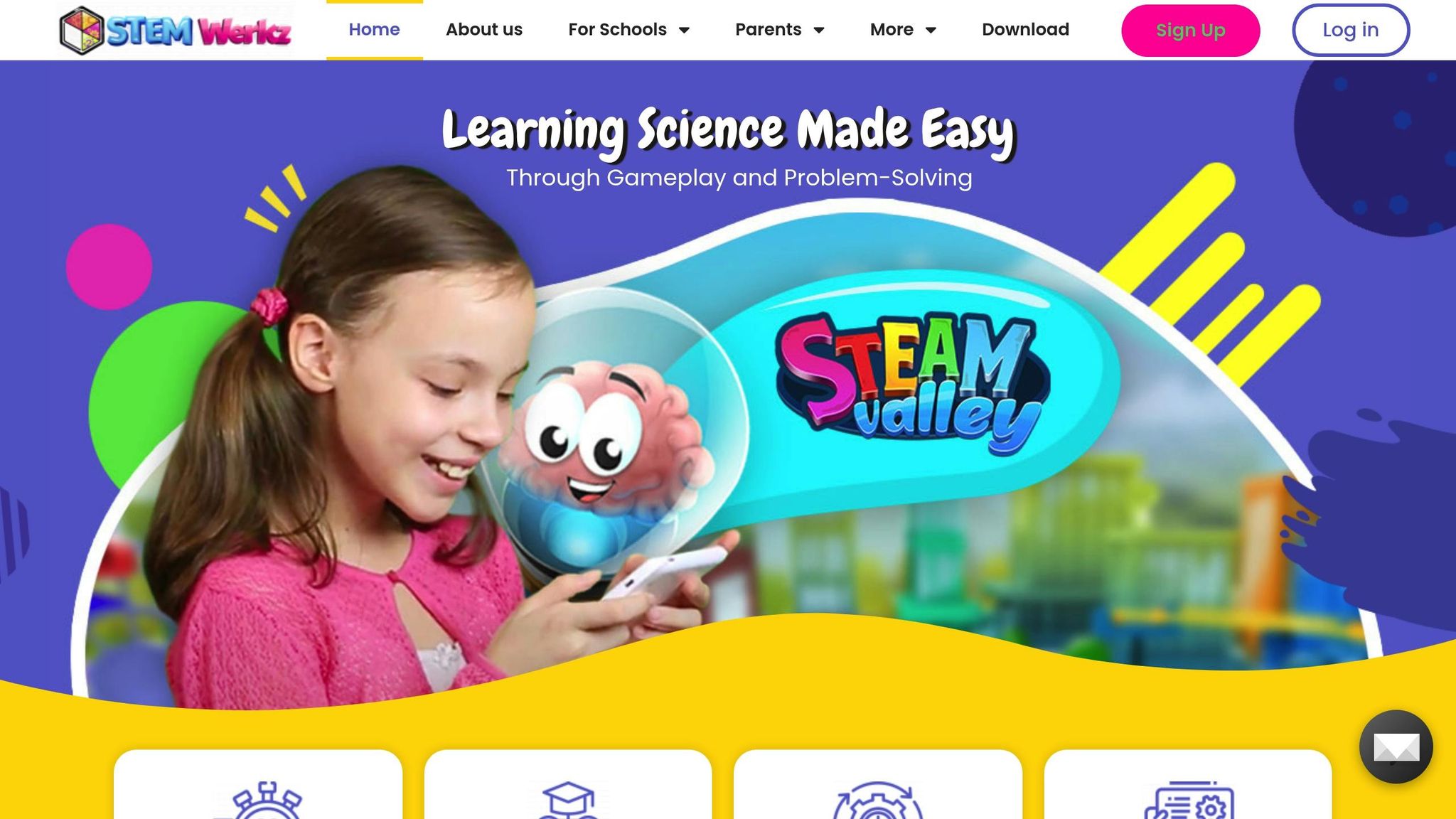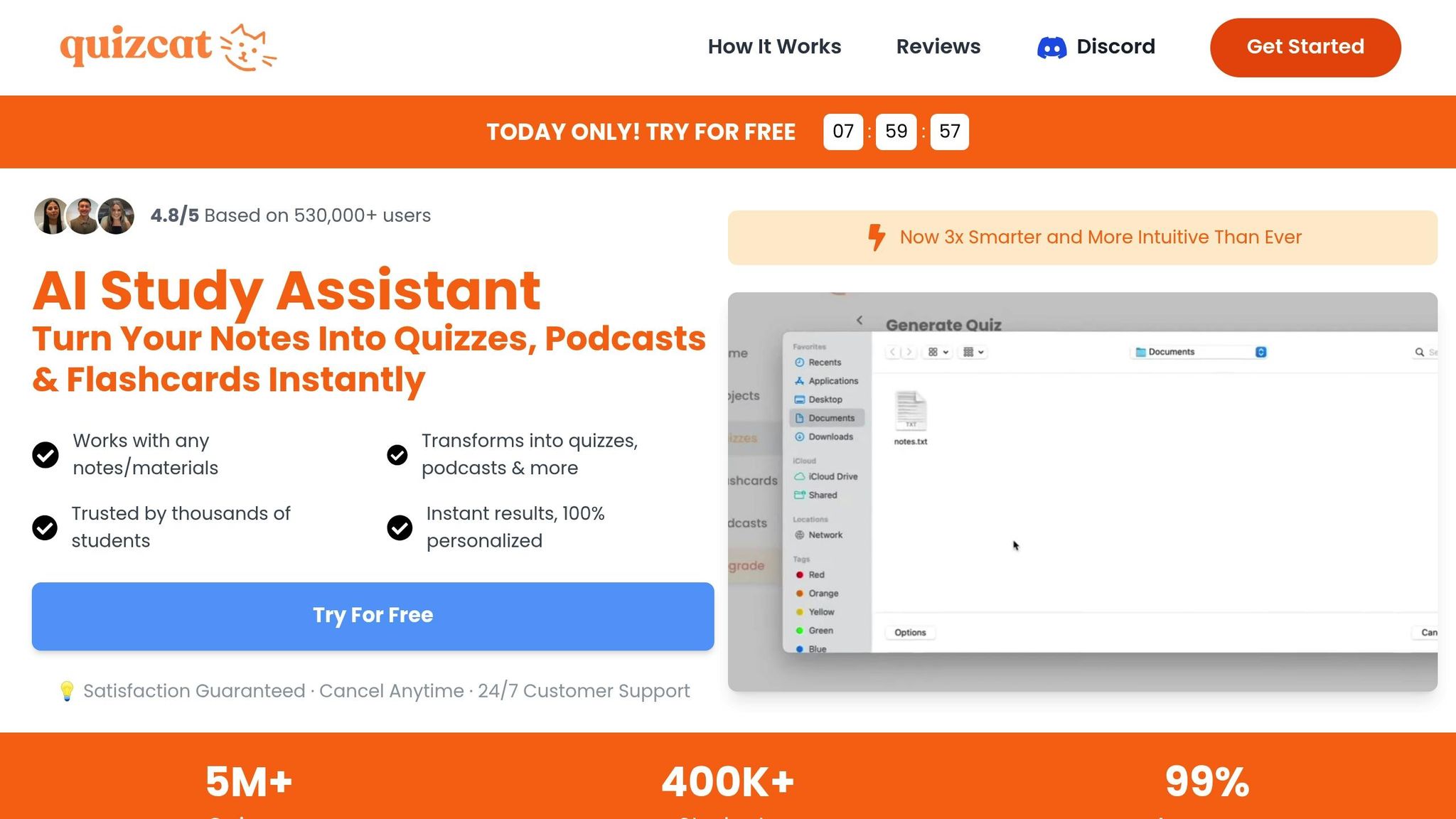
How Game-Based Apps Teach STEM Skills
Game-based learning apps are transforming STEM education by making complex topics interactive and engaging. These apps use AI to personalize learning, gamify tough subjects, and adapt to different learning styles. Here's what makes them effective:
- AI-Powered Personalization: Tailors lessons to individual needs, offering features like adaptive difficulty and smart review schedules.
- Gamification: Includes rewards like badges, progress tracking, and points to keep students motivated.
- Practical STEM Scenarios: Turns abstract concepts into real-world applications through challenges and problem-solving exercises.
- Coding Basics: Simplifies programming with step-by-step guides for sequences, loops, conditionals, and functions.
- 3D and Spatial Skills: Enhances visualization and understanding of complex structures, crucial for fields like engineering and chemistry.
- On-the-Go Learning: Features like podcasts allow students to study anywhere, anytime.
Example: Platforms like QuizCat AI have helped over 400,000 students by generating 5 million quizzes with 99% accuracy, making STEM learning accessible and effective.
Quick Tip: Combine game-based apps with tools like QuizCat AI to create interactive, personalized study plans that simplify STEM concepts and boost understanding.
STEM at home with STEMWerkz App - Review

Key Elements of STEM Learning Apps
Game-based STEM learning apps are designed to make learning interactive and fun. By combining engaging features with practical applications, these apps help students develop essential skills while staying motivated.
Game Elements and Rewards
Reward systems are at the heart of gamified learning, keeping students motivated and focused. These systems often include:
- Achievement badges to celebrate milestones and encourage progress
- Progress tracking to visualize mastery and goal completion
- Point systems that reward consistent effort and dedication
- Level-up mechanics that unlock new and advanced content
Take QuizCat AI, for example - it demonstrates how gamification can completely change the way students approach STEM learning.
"Literally a lifesaver during finals. Uploaded my notes, hit 'create,' and BOOM - quizzes and flashcards ready to go. It's like having a personal tutor 24/7." - Jake Harrison
STEM Scenarios and Examples
STEM concepts can sometimes feel abstract, but apps that incorporate real-world scenarios make these ideas easier to grasp. By using interactive challenges and problem-solving exercises, students can see how theoretical knowledge applies in practical settings, making lessons both memorable and meaningful.
"I was drowning in notes before I found this tool. Now, it turns everything into flashcards, quizzes, and even podcasts! Studying has never been this easy. 🚀 Highly recommend!" - Emily Carter
AI-Powered Learning Paths
Artificial intelligence is revolutionizing STEM education by tailoring learning experiences to each student’s needs. These apps analyze performance and adapt content to ensure effective learning, offering features like:
- Adaptive difficulty that adjusts based on how well a student is doing
- Smart review scheduling that focuses on areas needing improvement
- Performance analytics to highlight strengths and weaknesses
- Custom quiz generation tailored to individual progress
"Flashcards and quizzes are super accurate, but the podcast thing? Next level. I study while walking my dog now. It's a productivity hack for sure." - Chloe Adams
STEM Skills Taught Through Games
Game-based apps are reshaping how STEM skills are developed, with research showing they offer notable cognitive benefits (g = 0.46, p < 0.001). By turning complex ideas into interactive and practical experiences, these apps make STEM concepts more engaging and easier to understand.
Problem-Solving Skills
Game-based learning sharpens problem-solving by encouraging students to:
- Break challenges into smaller, manageable steps
- Analyze situations methodically
- Test ideas, adapt strategies, and learn from mistakes
- Use logical reasoning to find solutions
This hands-on approach not only builds confidence but also strengthens essential skills across STEM fields.
Coding and Programming Basics
STEM-focused apps introduce coding in a fun and approachable way, often using block-based programming and interactive visuals. They simplify key programming concepts like:
| Programming Concept | How It’s Taught | What Students Learn |
|---|---|---|
| Sequences | Step-by-step visual guides | Writing basic algorithms |
| Loops | Pattern-matching games | Coding efficiently |
| Conditionals | Decision-making challenges | Logical reasoning |
| Functions | Reusable code blocks | Modular programming skills |
This step-by-step method ensures learners grasp the basics before tackling more advanced topics. Research highlights improvements in motivation (g = 0.40, p < 0.001) and engagement (g = 0.44, p < 0.001). Beyond coding, many of these tools also nurture spatial reasoning abilities, which are key to STEM success.
3D and Spatial Understanding
Building on coding skills, interactive 3D environments play a vital role in developing spatial reasoning. These abilities are indispensable for fields like engineering, architecture, and chemistry. Through game-based learning, students enhance:
- Mental rotation and visualization
- Perspective-taking
- Understanding of complex 3D structures
Research shows that even young learners benefit from these spatial exercises, laying a solid foundation for future STEM education. The interactive nature of these tools lets students experiment with variables and see outcomes instantly, helping them grasp intricate STEM concepts more deeply.
sbb-itb-1e479da
Research on Game-Based STEM Learning
Studies show that game-based learning makes tough STEM topics easier to grasp while boosting critical thinking and problem-solving abilities. This aligns with earlier insights into how gamification and AI-powered personalized learning paths can improve educational outcomes. These discoveries pave the way for practical examples that highlight the real-world benefits of gamified STEM education.
Success Stories in STEM Apps
Inspired by this research, educational apps are turning traditionally difficult subjects into interactive and enjoyable learning experiences. These tools not only keep students engaged but also help them build a solid understanding. One student, Sophia Martinez, shared her experience:
"I was skeptical at first, but wow. The quizzes it makes from my notes are so spot-on. My test scores have gone up, and I actually enjoy studying now. Who even am I? 😅" – Sophia Martinez
Using QuizCat AI with STEM Games

Pairing study tools with game-based STEM apps can elevate learning experiences to a whole new level. QuizCat AI has positioned itself as an essential tool in modern STEM education, making complex topics more approachable and interactive. Here's how it stands out.
Turning Notes into Interactive Study Tools
QuizCat AI transforms STEM notes into dynamic study materials. With an impressive 99% accuracy rate in content generation, it offers students the chance to engage with STEM concepts in multiple ways. Students can upload their notes in formats like PDF, DOCX, or TXT and instantly receive customized study aids designed to enhance their understanding.
Mastering STEM Topics Through Practice
QuizCat AI's quiz generation system is designed to test and reinforce students' understanding of STEM concepts. With over 5 million quizzes created and used by more than 400,000 students, it's clear the platform has made a significant impact. The system pinpoints knowledge gaps and offers personalized study paths to help students strengthen those weaker areas.
Here’s a quick look at how QuizCat AI supports STEM learning:
| Feature | How It Helps in STEM Learning |
|---|---|
| Smart Flashcards | Quickly review formulas and key concepts |
| Interactive Quizzes | Reinforce understanding of game-based lessons |
| Personalized Paths | Target areas where improvement is needed |
On top of quizzes and flashcards, QuizCat AI also makes learning more accessible with mobile-friendly features.
STEM Learning on the Go
QuizCat AI takes convenience to the next level with its podcast feature, which converts STEM materials into audio lessons. This flexibility allows students to learn wherever they are. Unsurprisingly, this feature has contributed to the platform’s stellar 4.8/5 rating from over 530,000 users.
Conclusion: Next Steps in Game-Based STEM Learning
The future of STEM education is heading toward a blend of game-based learning apps and AI-driven study tools. A great example of this shift is QuizCat AI, which has already created over 5 million quizzes with an impressive 99% accuracy rate.
To build on this progress, educators and students should focus on combining interactive gaming with AI-powered tools for a more engaging and personalized learning experience. With more than 400,000 students already using these advanced methods, the adoption of AI-enhanced education is clearly gaining traction.
Here’s what’s essential moving forward:
- Expand Learning Formats: Use game-based apps alongside AI tools to provide well-rounded practice and reinforcement.
- Leverage Mobile Learning: Take advantage of audio lessons and features designed for studying on the go.
- Tailor Study Plans: Rely on AI-generated content to focus on specific areas where improvement is needed.
As these tools continue to evolve, they’ll unlock even greater opportunities for students to grasp challenging STEM concepts in a way that's both effective and enjoyable. The 4.8/5 rating from over 530,000 users highlights just how impactful this combination of game-based and AI-powered tools can be. Now’s the time to embrace these innovations and transform the way STEM education is delivered.
FAQs
How do game-based learning apps help students develop STEM skills?
Game-based learning apps bring STEM education to life by blending interactive gameplay with educational content. Through challenges, puzzles, and simulations, these apps introduce concepts in science, technology, engineering, and math while fostering critical thinking and problem-solving skills. The result? Students learn complex topics in a way that feels more like play than work.
Some of these apps take things a step further by incorporating AI technology. This allows them to customize the learning experience for each student. By analyzing performance and progress, these tools can adjust difficulty levels, offer precise feedback, and target areas where a student might need extra help. This tailored approach keeps learning effective and engaging, no matter the student's skill level.
What are the benefits of using game-based apps to teach STEM skills, and how do they boost student motivation?
Game-based apps transform STEM learning into an engaging experience by combining education with interactive gameplay. These apps simplify complex STEM concepts through hands-on problem-solving and simulations that mimic real-world scenarios, making the learning process both enjoyable and practical.
With features like rewards, challenges, and progress tracking, these tools use gamification to keep students motivated. They promote active participation and create a sense of accomplishment, helping learners stay focused and committed. Beyond just understanding concepts, this method sharpens problem-solving and critical thinking skills - key abilities for thriving in STEM fields.
How do game-based apps help students develop 3D and spatial skills for STEM fields like engineering and chemistry?
Game-based learning apps aim to captivate students through interactive experiences that enhance 3D visualization and spatial reasoning - skills that are essential in STEM fields like engineering and chemistry. These apps leverage tools like simulations, puzzles, and virtual environments to simplify complex topics, whether it's understanding molecular structures in chemistry or exploring architectural designs in engineering.
By placing students in engaging, problem-solving scenarios, these apps promote critical thinking and spark creativity. Activities like constructing 3D models or navigating virtual spaces help sharpen spatial awareness and the ability to visualize objects from multiple angles - key abilities for excelling in STEM subjects.
